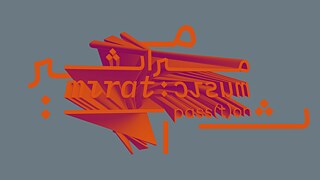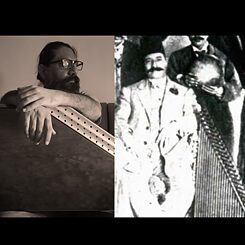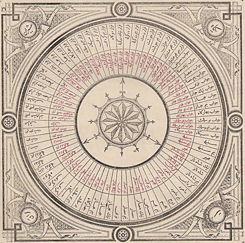Ghassan Sahhab
Conversation With Mohammad Al-‘Aqqad
Born in Damietta (دمياط) Egypt, sometime between 1841 and 1851, Mohammad Al-‘Aqqad is one of the master qānūn players of the late 19th and early 20th centuries. Al-‘Aqqad passed away in Cairo around 1930, but his compositions have had a great influence on Ghassan Sahhab. In his work on the qānūn for this track, Ghassan applied Al-’Aqqad’s musicality, creativity, and virtuosity, all of which gives direction and motivation to his practice. Unlike today’s practices on the qānūn, Al-‘Aqqad worked with the qānūn without levers—these were introduced in the late 19th century and were a major development on the music scene at the time, a development that Al-‘Aqqad refused to adopt into his own practice.
Ghassan chose to interact with this great improviser of the 19th century through a musical piece titled “Taqasim Saba ‘ala Al-Wahda” (Taqasim form, in Saba mode and Wahda cycle) recorded in 1921; exactly a hundred years ago. The recording was kept and digitized at the Foundation for Arab Music Archiving and Research (AMAR) in Lebanon.
Playing the original recording of “Taqasim Saba ‘ala Al-Wahda” in the studio while also performing on his own qānūn, Sahhab enters into a musical dialogue with Al-‘Aqqad; a form of question and answer. In doing so he also employs the Taqsim, a classical instrumental improvisation form used in the Levant. The contemporary sound of Sahhab’s qānūn converses freely with the unlevered qānūn of times past. The whole conversation is built on the concept that heritage is not a solid or dead material, but a living reflection of cultural identity.
Despite the different time periods, historic events, and technological innovations, both artists meet in one track, sharing the same language—that of the maqam.
Duration: 3:30
Instrumentation: qānūn
Date of original recording: 1921
Archive used: Foundation for Arabic Music and Research (AMAR)
Composition: improvisation
Date of recording: August 2021
Sound engineer: Fadi Tabbal
Recording studio: Tunefork Studios
Unrevealed
The two concepts “authenticity” and “tradition” are often used when speaking about music, but they are largely misused both linguistically and philosophically. In an effort to contemplate the difference between the two from a musical perspective, Ghassan Sahhab has taken several musical works, mixed and matched them, and composed a track called “Unrevealed.”
In “Unrevealed,” the listener is invited to take an active part in the listening and thinking process in order to infer the different historic and temporal contexts that surround each melody. The track provokes the listener to identify distinct musical elements that are unified insofar as they share the same cultural identity.
The musical content for this track is taken from two manuscripts and one old recording that come from three different eras, consciously selected by the artist based on his personal experience with notated works, manuscripts, and archives. The first piece is a melody from the Abbasid era (13th century) written by Safi ed-Din el-Urmawi in his book “Kitab al-Adwar.” The second comes from a melody written in the 19th century by Mikha’il Mashaqa in his book “Al-Risala Al-Shahabiyya,” and the third is a well-known instrumental piece called “Sama’i Darej Bayati,” which the artist took from a recording that was done between 1903 and 1932.
The artist uses his musical memory and knowledge to imagine and perform a coming together of the three melodies, all of which are based on the same maqam. Using their musical grammar, Sahhab reinterprets, improvises, and blends their contents to produce a single piece. He meticulously selects the elements that he wants to present in this contemporary take on centuries old melodies.
Duration: 3:40
Instrumentation: qānūn
Date of original recording: 13th century, 19th century, 20th century
Archive used: Foundation for Arabic Music and Research (AMAR)
Composition: improvisation
Date of recording: August 2021
Sound engineer: Fadi Tabbal
Recording studio: Tunefork Studios
The Why Behind The Music
Ghassan Sahhab
My experience in music has evolved over the course of a long quest in musical learning, education, research, composition and performance. I first began to hone my musical practice and passion with the qānūn[1], one of the core instruments of modal music in the Levant. Then came a pivotal moment for understanding music when I started to do research and wanted to share my findings with others.My contribution to Mirath:Music is a continuation of my work both at me’azaf (my musical, cultural initiative) and in my wider musical activities and practices. In this project I went back to the sources with which I am most familiar, such as audio archives, manuscripts, tablets, and written and oral testimonies. I also followed in the footsteps of the movement that renews music from within the classical modal tradition.
While working on my project I wanted to highlight the importance of our locally rooted Levantine musical language, and to showcase its complexity, versatility, and diversity. I did so by playing and composing on the qānūn. Throughout the compositions I put my learnings into musical practice. The work accentuates the manifold potentials of modal/maqam music in contrast to western harmonic thinking, which has been increasingly present in musical practices in the Levant.
Western musical influences entered the region’s musical practices through education, the record industry, and in many cases through music production and dissemination that is oriented towards the Global North. This became visible when the orchestra invaded the musical scene at the expense of the familiar takht, and music education became institutionalized within educational and religious structures. Up until that point our local musical practices were built on deep relationships between the teacher or murshid (meaning the one who guides) and the student or mureed (the one who seeks). Returning to these practices, my compositions provide a counterexample, tapping into what I have absorbed through praxis.
[1] Qanun: a string instrument consisting of 78-81 strings stretched over a trapezoidal sounding board.
Interview with Ghassan Sahhab


